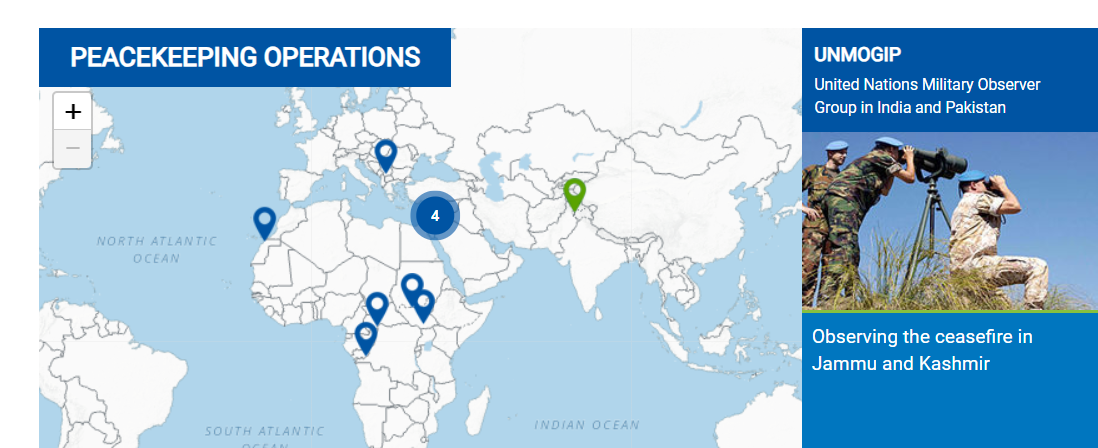Dag Hammarskjöld Medal and International Day of UN Peacekeepers | 31 May 2024
For Prelims: Dag Hammarskjöld Medal, Democratic Republic of Congo, United Nations, International Day of UN Peacekeepers, UN peacekeeping mission
For Mains: Role of UN Peacekeeping in resolving conflicts and promoting peace, India's contributions
Why in News?
Indian peacekeeper Naik Dhananjay Kumar Singh, who served with the United Nations Stabilisation Mission in the Democratic Republic of Congo (MONUSCO), will be posthumously awarded the prestigious Dag Hammarskjold medal for his service and sacrifice.
Note:
- Naik Dhananjay Kumar Singh served under the United Nations (UN) flag as part of MONUSCO. He lost his life in the line of duty, demonstrating unwavering commitment to peacekeeping efforts.
- MONUSCO took over from a previous U.N. peacekeeping mission in the African country in 2010.
- MONUSCO aims to protect civilians, humanitarian personnel and human rights defenders from the imminent threat of physical violence and to support the government of the country in its stabilisation and peace consolidation efforts.
What is the Dag Hammarskjöld Medal?
- The Dag Hammarskjöld medal was established in December 2000 as a posthumous award to members of peacekeeping operations who lost their lives during service with a peacekeeping operation under the operational control and authority of the United Nations.
- It is named after former UN Secretary-General Dag Hammarskjöld, who died in a plane crash while on a peacekeeping mission in 1961.
- Each year on Peacekeeper's Day (29th May), this medal is awarded to any Member State who has lost one or more military or police peacekeepers at a ceremony at headquarters of the UN.
International Day of UN Peacekeepers
- The International Day of UN Peacekeepers was established by the UN General Assembly in 2002, to pay tribute to all men and women serving in peacekeeping, and to honour the memory of those who have lost their lives in the cause of peace.
- 2024 Theme: 'Fit for the future, building better together', emphasises the evolution and adaptability of UN Peacekeeping to address future conflicts.
What is the U.N. Peacekeeping Mission?
- The U.N. Peacekeeping mission is a joint effort between the Department of Peace Operations and the Department of Operational Support and aims to assist host countries to transition from situations of conflict to peace.
- UN Peacekeeping was established during the Cold War when the Security Council was often paralysed by rivalries.
- The first two peacekeeping operations deployed by the UN were the UN Truce Supervision Organization (UNTSO), in 1948 to monitor the Armistice Agreement between Israel and its Arab neighbours and the UN Military Observer Group in India and Pakistan (UNMOGIP), in 1949.
- More than two million peacekeepers from 125 countries have served in 71 operations around the world. Today, about 76,000 women and men are serving in 11 conflict zones across Africa, Asia, Europe, and the Middle East.
- The three main principles guiding the U.N. Peacekeeping missions are Consent of the parties, Impartiality, and the Non-use of force except in self-defence and defence of the mandate.
What is India's Contribution to UN Peacekeeping?
- Contribution: India is the second largest contributor of uniformed personnel to UN Peacekeeping.
- Over 200,000 Indians have served in 49 U.N. Peacekeeping missions since 1948.
- Presently, the Indian Armed Forces are deployed across nine countries in peacekeeping missions. 160 Indian Army soldiers have made the ultimate sacrifice for global peace.
- The Indian Army has established a Centre for UN Peacekeeping (CUNPK) in New Delhi to impart niche training in peacekeeping operations. This Centre trains more than 12,000 troops every year.
- The UN has mandated targets to increase women peacekeepers' participation as part of its gender parity drive to better address local women's concerns in missions.
- India has deployed Female Engagement Teams (FETs) in the Democratic Republic of Congo and Abyei, the second-largest Indian women contingent after Liberia.
- Major Radhika Sen has been selected for the "Military Gender Advocate of the Year 2023" award by the UN Headquarters, showcasing the positive contribution of Indian women in UN peacekeeping initiatives.
- In 2007, India deployed an all-women Formed Police Unit to the UN Operation in Liberia (UNMIL), making it the first country to send an all-women contingent to a UN Peacekeeping mission.
- India's Displeasure with UNMOGIP: Despite its presence in several countries as part of the Peacekeeping missions, India has routinely expressed its displeasure at the UNMOGIP mission headquartered in Srinagar and Islamabad. The UNMOGIP was established in 1949 to supervise the ceasefire between India and Pakistan.
- UNMOGIP has remained in the region to observe hostilities between the neighbouring countries and report ceasefire violations along the Line of Control (LoC).
- India has reiterated that the mission has “outlived its relevance” after the Simla Agreement was signed by India and Pakistan in July 1972 and the establishment of the LoC.
Read more: India's Commitment to UN Peacekeeping, Peacebuilding Through The United Nations
|
Drishti Mains Question: Q. Discuss the evolution and guiding principles of the UN Peacekeeping mission, and highlight India's contribution to global peacekeeping efforts. |
UPSC Civil Services Examination Previous Year Question (PYQ)
Prelims
Q. The Security Council of UN consists of 5 permanent members, and the remaining 10 members are elected by the General Assembly for a term of (2009)
(a) 1 year
(b) 2 years
(c) 3 years
(d) 5 years
Ans: (b)

